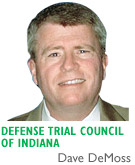Subscriber Benefit
As a subscriber you can listen to articles at work, in the car, or while you work out. Subscribe Now
 No one would ever confuse me with someone with high computer literacy. My introduction to computers in 1974 consisted of hauling around large boxes of computer input cards programmed to spell out my pizza order. But I do recognize the changes in technology have had an impact and created opportunities for our profession. Over the past 20-plus years, I have seen technological changes that have enhanced our ability to practice more efficiently and effectively for our clients. Our office started with a simple IBM single terminal computer that responded only to the mysterious DOS language command I struggled to grasp. The next big thing was the addition of a fax machine with all its beeping, screeching, whirring and innate ability to run out of paper when we weren’t looking.
No one would ever confuse me with someone with high computer literacy. My introduction to computers in 1974 consisted of hauling around large boxes of computer input cards programmed to spell out my pizza order. But I do recognize the changes in technology have had an impact and created opportunities for our profession. Over the past 20-plus years, I have seen technological changes that have enhanced our ability to practice more efficiently and effectively for our clients. Our office started with a simple IBM single terminal computer that responded only to the mysterious DOS language command I struggled to grasp. The next big thing was the addition of a fax machine with all its beeping, screeching, whirring and innate ability to run out of paper when we weren’t looking.
Technological advances soon led us to having a desktop computer connected to our office network. We had the ability to conduct legal research online through Lexis or Westlaw, although our library still bulged with various essential collections of statutes, caselaw, and a host of how-to manuals. Our case management system continued to evolve to the point where the lawyers could actually use it without conferring with a secretary or a paralegal. Oh, and the mobile phone seemed to be catching on with some zeal. You could have one installed in your car, or you could get a portable phone akin to the size of a loaf of bread. Like time, technology marched on.
Recent years have brought a host of innovations, sparking something of a revolution in the way we obtain information and communicate. The growing acceptance of electronic communication presents new challenges. Our smart phones are now smarter than we are. Cell phone use is old hat; texting or tweeting is becoming main stream. Many households have abandoned their traditional landlines and are purely cellular.
Communicating with clients may mean a cell phone, an e-mail in addition to, or in lieu of, traditional snail mail, requiring us to discover their preferences. What if your client gives you a work e-mail address? In most instances, employers warn that their computer communications may be subject to review. Using a home e-mail address does not guarantee confidentiality. Maintaining the attorney-client privilege in such communications may mean the use of encryption software. Does your practice utilize encryption or have clearly defined rules regarding what may and may not be communicated by e-mail? Has your client given informed consent to unprotected electronic communications?
The proliferation of the Internet and social networking sites has spawned a host of variations in well-established legal issues. Defamation suits and suits for intentional infliction for emotional distress over postings made on social media sites such as Facebook, Twitter, or in blogs are becoming more common. Does your practice include counseling individual or corporate clients on the potential liability exposure from such activities?
The rapid pace of technological development requires some measure of vigilance to determine what changes, if any, are necessary to maintain an efficient practice. In 2005 we converted our practice from a paper file to an electronic file environment. Each day’s mail is scanned and filed electronically. Laptops with aircards, wireless hot spots, or home routers have allowed our lawyers to have access to their daily mail and all of their cases from remote locations. There are other benefits too numerous to list, but from my point of view it was well worth the move. The same capacity scanners we purchased then have gone down in price by about 70 percent, making such a move even more cost effective today.
As confessed above, I am not particularly computer literate, but I will point out two pieces of software to take a look at for your practice. The first, Snagit®, is very simple screen capture software that allows you to export and import information from one source to another with great ease. The second, AutoBookmark™ plug-in for Adobe Acrobat®, is an enhancement allowing you to sort and manage Bookmarks made in Adobe® documents; very handy when dealing with large volume records you want to index or organize.
There will be a day when all of the courts in the state are electronic, web-based information exchange portals will become a normal part of the practice, and video conferencing will be a routine matter. The technology is already in place, it’s now just a matter of adoption and refinement. Continue to examine the mechanics of your practice and keep your mind and eyes open to technological advances that improve the efficiency of your office and benefit your clients in the long run. And for more technical computer “stuff,” read Stephen Bour’s column, Technology Untangled.•
__________
David DeMoss serves as managing attorney for State Farm Litigation Counsel in Indianapolis. He is a member of the DTCI board of directors and serves on the association’s legislative committee and as PAC treasurer. The opinions expressed in this article are those of the author.
Please enable JavaScript to view this content.
